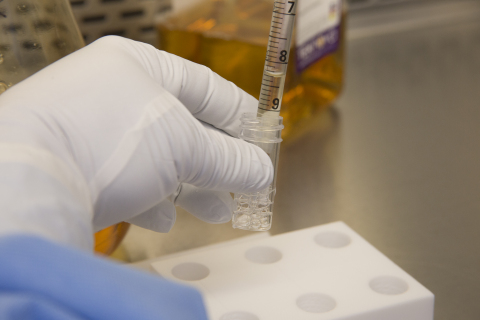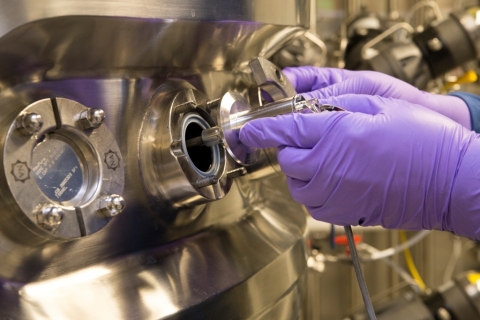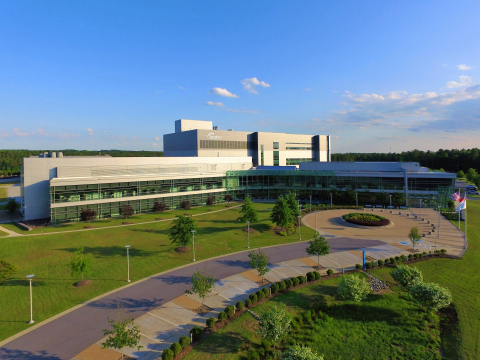HOLLY SPRINGS, N.C.--(BUSINESS WIRE)--Seqirus, a leading innovator in influenza vaccines and pandemic preparedness, today announced the next major advancement in the use of cell-based technology at its state-of-the art manufacturing facility in Holly Springs, North Carolina.
In an industry first, Seqirus has successfully produced cell-based influenza vaccine at commercial scale using a candidate vaccine virus (CVV) that has been isolated and grown in cells, rather than in eggs.1,2 CVVs are prepared by the World Health Organization (WHO) Global Influenza Surveillance and Response System (GISRS) and associated laboratories, and are used by manufacturers to develop and produce influenza vaccines.
The use of cell-derived CVVs, rather than egg-derived CVVs, has the potential to drive improved process control and increased output in the production of cell-based influenza vaccines. In addition, influenza viruses isolated and grown exclusively in cells can be more similar to influenza viruses in circulation.3,4
Since first beginning production in 2014, the Holly Springs site has used egg-derived CVVs in its cell-based manufacturing process. In 2016, the WHO began to also recommend cell-derived CVVs and the US Food and Drug Administration (FDA) issued an approval for Seqirus to use them in the production of cell-based influenza vaccines at Holly Springs.4,5
This year, Seqirus was successful in using a cell-derived H3N2 CVV in the production of its cell-based seasonal influenza vaccine, making the end-to-end production of this particular strain exclusively cell-based.1 The company plans to utilize cell-derived CVV technology for the production of other vaccine strains produced at the Holly Springs site in the future.
“Cell-based influenza vaccines represent one the most significant advancements in the history of influenza vaccine production. Seqirus is proud to continue to innovate this promising technology as part of our leading role in influenza prevention and pandemic preparedness,” said Gordon Naylor, President of Seqirus.
“The successful application of this new technology reflects the deep expertise that exists within Seqirus, developed over our 100-year heritage in influenza. It will improve our overall production process and enhance our ability to deliver on our commitment to public health.”
The Holly Springs facility was purpose-built in partnership the U.S. Biomedical Advanced Research and Development Authority (BARDA) to help combat pandemic threats.6,7 This latest milestone is the result of a multi-year collaboration involving the WHO Collaborating Centre for Surveillance, Epidemiology and Control of Influenza at the U.S. Centers for Disease Control and Prevention (CDC), the WHO Collaborating Centre for Reference and Research on Influenza in Melbourne, Australia, and scientists at Seqirus and its predecessor company. The cell-based H3N2 CVV used by Seqirus was developed by the WHO Collaborating Centre in Melbourne from a sample originally obtained from the National Influenza Centre in Singapore.
“This major advancement would not have been possible without significant global collaboration and is a fine example of how industry and public health agencies can work together to better combat influenza,” said Naylor.
About Seasonal Influenza
Influenza is a common, contagious
infectious disease that can cause severe illness and life-threatening
complications in many people. To reduce the risk of more serious
outcomes, such as hospitalization and death, resulting from influenza,
the CDC recommends annual vaccination for all individuals aged six
months and older.8 Because transmission to others may occur
one day before symptoms develop and up to five to seven days after
becoming sick, the disease can be easily transmitted to others.8
Influenza can lead to clinical symptoms varying from mild to moderate respiratory illness to severe complications, hospitalization and in some cases death.8 The CDC estimates that 310,000 people in the United States were hospitalized due to influenza-related complications during the 2015-2016 influenza season.9 Since it takes about two weeks after vaccination for antibodies to develop in the body that protect against influenza virus infection, it is best that people get vaccinated to help protect them before influenza begins spreading in their community, and by the end of October if possible.8
About Seqirus
Seqirus is part of CSL
Limited (ASX:CSL), headquartered in Melbourne, Australia. The CSL
Group of companies employs almost 20,000 people and supplies life-saving
medicines to more than 60 countries.
Seqirus was established on 31 July 2015 following CSL’s acquisition of the Novartis influenza vaccines business and its subsequent integration with bioCSL. As the second largest influenza vaccine provider in the world, Seqirus is a major contributor to the prevention of influenza globally and a transcontinental partner in pandemic preparedness.
Seqirus operates state-of-the-art production facilities in the US, the UK and Australia, and manufactures influenza vaccines using both egg-based and cell-based technologies. It has leading R&D capabilities, a broad portfolio of differentiated products and a commercial presence in more than 20 countries.
For more information visit www.seqirus.com and www.csl.com.
Media Information
Interviews with Gordon Naylor, Seqirus
President, and Ethan Settembre, Seqirus Vice-President of Research, can
be arranged through Nate Gilbraith, +1 (612) 455-1915, Nate.Gilbraith@padillaco.com
or Kim Blake, +1 (757) 635-5658, kim.blake@padillaco.com.
Further images and b-roll footage of the Holly Springs facility be downloaded from: http://www.seqirus-us.com/images-broll.htm
References
1 US Department of Health & Human Services. Supplement Approval. Available at https://www.fda.gov/downloads/BiologicsBloodVaccines/Vaccines/ApprovedProducts/UCM522280.pdf. Accessed May 2017.
2 Ambrozaitis A, et al. A novel mammalian cell-culture technique for consistent production of a well-tolerated and immunogenic trivalent subunit influenza vaccine. Vaccine. 2009;27:6022–6029. doi:10.1016/j.vaccine.2009.07.083.
3 Barr et al. WHO recommendations for the viruses used in the 2013-2014 Northern Hemisphere influenza vaccine: Epidemiology, antigenic and genetic characteristics of influenza A(H1N1) pdm09, A(H3N2) and B influenza viruses collected from October 2012 to January 2013. Available at: http://www.sciencedirect.com/science/article/pii/S0264410X1400187X?via%3Dihub. Accessed June 2017.
4 World Health Organization. Improving influenza vaccine virus selection, Report of the 4th WHO Informal Consultation Hong Kong. Available at http://www.who.int/influenza/resources/publications/Influenza_vaccine_virus_selection_report/en/. Accessed June 2017.
5 World Health Organization. Recommended composition of influenza virus vaccines for use in the 2017-2018 northern hemisphere influenza season. Available at http://www.who.int/influenza/vaccines/virus/recommendations/201703_recommendation.pdf?ua=1. Accessed June 2017.
6 US Department of Health & Human Services. A milestone in protection from influenza. US Department of Health and Human Services website. Available at: http://www.hhs.gov/news/press/2014pres/06/20140617a.html. Accessed April 2016.
7 This project has been funded in whole or in part with Federal funds from the Office of the Assistant Secretary for Preparedness and Response, Biomedical Advanced Research and Development Authority, under Contract No. HHSO100200900101C.
8 Centers for Disease Control and Prevention (CDC). “Key Facts About Seasonal Flu Vaccine.” Available at: http://www.cdc.gov/flu/protect/keyfacts.htm. Accessed June 2017.
9 CDC. “Seasonal Influenza-Associated Hospitalizations in the United States.” Available at: https://www.cdc.gov/flu/about/qa/hospital.htm. Accessed June 2017.




